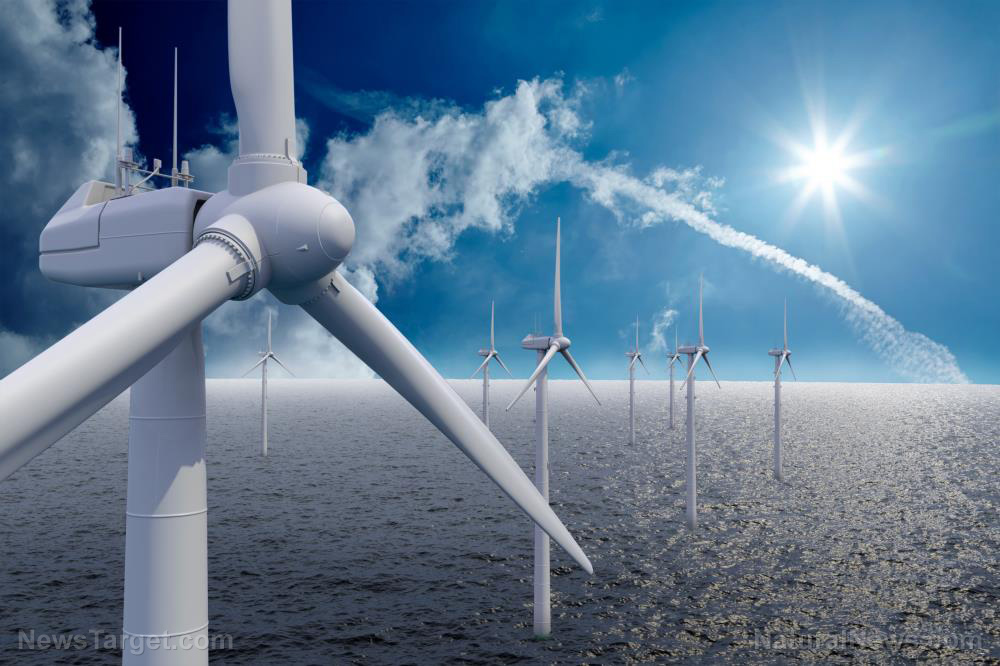Wind power emits 75 percent less carbon than solar energy, according to new report
05/06/2021 / By Virgilio Marin

Wind turbines’ carbon emissions remain substantially low compared to solar panels and even more so compared to fossil fuels. This is according to a new report from analysis firm Bernstein Research, which shows that wind power emits 75 percent less greenhouse gases than solar energy.
Green energy advocates have long espoused expanding the use of wind and solar to reduce carbon emissions. But though both of these renewables are green by themselves, capturing them requires machines that are carbon-intensive to make. In the case of wind, building and erecting wind turbines require a lot of materials, such as steel, concrete, fiberglass and copper, as well as exotic materials sourced from deep beneath the surface of Earth.
Producing these leaves a significant carbon footprint. Steelmaking, for example, typically involves burning coal in blast furnaces while mining metals and rare elements requires a lot of energy. Producing concrete, on the other hand, emits large amounts of carbon dioxide.
But wind and solar’s emissions are front-loaded, meaning the majority of their carbon footprint is created and emitted during the manufacturing process. By contrast, fossil-fueled power plants release greenhouse gases continuously as fossil fuels are burned.
With that in mind, author and Bernstein senior analyst Deepa Venkateswaran measured how much carbon dioxide these sources of electricity actually emit when the carbon cost is amortized over the lifespan of the equipment.
Using data from Bernstein and other research firms, she determined that wind turbines emit an average of 11 grams of carbon dioxide per kilowatt-hour (g/kWh). That is considerably lower than coal’s 1,000 g/kWh, natural gas’s 450 g/kWh and solar’s 44 g/kWh. Nuclear power, on the other hand, emits lower amounts of carbon dioxide than any of them, at nine g/kWh.

Based on these figures, she estimated that wind power emits 99 percent less carbon than coal-fired power plants, 98 percent less than natural gas and 75 percent less than solar.
According to Venkateswaran, the biggest contributors to wind turbines’ carbon footprint are steel, aluminum and the epoxy resins that hold pieces together. The steel tower makes up 30 percent of the turbines’ carbon footprint while the concrete foundation accounts for 17 percent. The share of carbon fiber and fiberglass blades, on the other hand, stands at 12 percent. (Related: Future wind power costs are 50% lower than predicted five years ago, study shows.)
Wind power will be greener with green steel
The Bernstein Research report comes as a handful of steelmakers start transitioning to green steel, which is steel produced using renewable energy. Green steel is seen as a viable solution to decarbonizing emissions-heavy industries that are reliant on steel, such as the manufacture of wind turbines.
Traditionally, steelmakers extract iron (the core material used for making steel) from ores by heating blast furnaces to above 1,800 degrees. These towering furnaces are loaded with raw materials such as coke, a coal-derived fuel that removes oxygen from iron oxide. A byproduct of this extraction is carbon dioxide.
But Swedish steelmaker SSAB is currently exploring the use of green hydrogen, which is hydrogen gas produced using renewables, in place of coal. The firm says that transitioning to this clean fuel will reduce its carbon dioxide emissions to virtually zero, with water vapor as the only byproduct.
To produce green hydrogen, SSAB splits water into its constituent oxygen and hydrogen molecules and then captures the hydrogen for steelmaking. The firm relies on Sweden’s abundant renewable electricity to power this splitting process, which is called electrolysis. The resulting hydrogen is then used to extract iron instead of coal or natural gas.
Besides SSAB, Austria’s Voestalpine and Luxembourg’s ArcelorMittal, which is Europe’s biggest steelmaker, are also developing similar projects.
Learn more about wind power and other renewables at NewEnergyReport.com.
Sources include:
Tagged Under: carbon dioxide, carbon emissions, carbon footprint, Clean Energy, electricity, electrolysis, energy, environment, future science, future tech, green energy, green hydrogen, green living, green steel, greenhouse gases, innovation, renewable energy, renewables, science and technology, solar energy, solar power, steelmaking, technology, wind energy, wind power, Wind Turbines





















